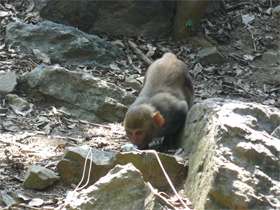Body odor sets female rhesus monkeys apart

Rhesus monkeys (Macaca mulatta) make use of their sense of smell to distinguish between members of their own and other social groups, according to new research, led by Stefanie Henkel (University of Leipzig, Germany), published in Springer's journal Behavioral Ecology and Sociobiology.
Social animals use their olfactory ability to distinguish between members of their own species. This generally helps them defend their territories, or to find sleeping sites or mating partners better. Primates, especially Old World monkeys and apes, are said to have a poor sense of smell, but researchers are now starting to realize that olfaction in these animals may play a greater role in their social lives than previously thought.
In contrast to previous studies on olfaction, the present study used a species which does not have any distinct scent glands and does not perform scent marking typical for olfactory communication among conspecifics. To investigate the role of smell in rhesus macaques, Henkel et al. conducted a study on the island Cayo Santiago in Puerto Rico (USA) during the non-mating season. The experiment was designed to explore whether the monkeys can discriminate between body odours of female group members and those of females from different social groups. Body odour samples collected from 33 adult females were placed in individual aerated metal containers. The researchers presented these odour samples to 74 unrelated conspecifics, as identified from extensive pedigree data available for this population, and observed their behavioral response.
The results revealed that monkeys of both sexes inspected the smell of females from other groups longer than the smell of females of the same group, probably because they were more familiar with the odours of individuals belonging to their own social group. Males and older monkeys were more likely to give the odour samples an inspecting lick than females or younger animals, respectively.
Interestingly, the monkeys placed their nose longer towards odour samples of an animal from a group that ranked higher than their own. The authors suggest that monkeys probably know the hierarchical status of their own group in relation to other groups, and that their sense of smell therefore helps them to better understand their social environment.
"Our findings for the first time uncover key roles of olfactory communication in a primate species not possessing distinct scent glands and thus may help to shed light into the evolution of primate olfactory communication," says Henkel.
"However," the author adds, "although our results suggest that rhesus macaques are able to distinguish between in-group and out-group individuals based on olfactory cues alone, the recognition of conspecifics might be a more multimodal process also including visual cues or a combination of olfactory and auditory signals. Further research is necessary to fully understand the underlying mechanisms of recognition processes".
More information: Stefanie Henkel et al. Rhesus macaques (Macaca mulatta) recognize group membership via olfactory cues alone, Behavioral Ecology and Sociobiology (2015). DOI: 10.1007/s00265-015-2013-y
Journal information: Behavioral Ecology and Sociobiology
Provided by Springer





















